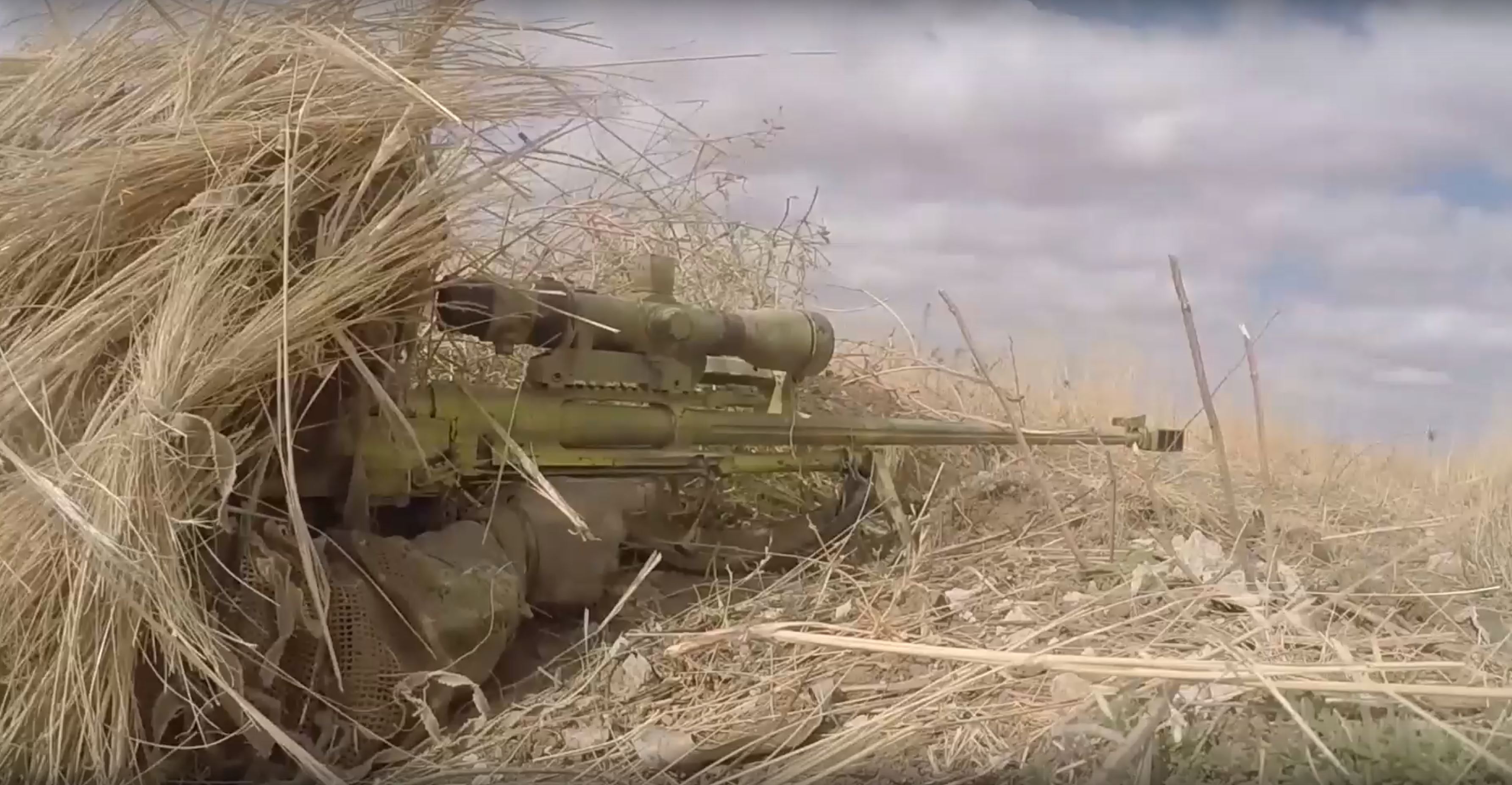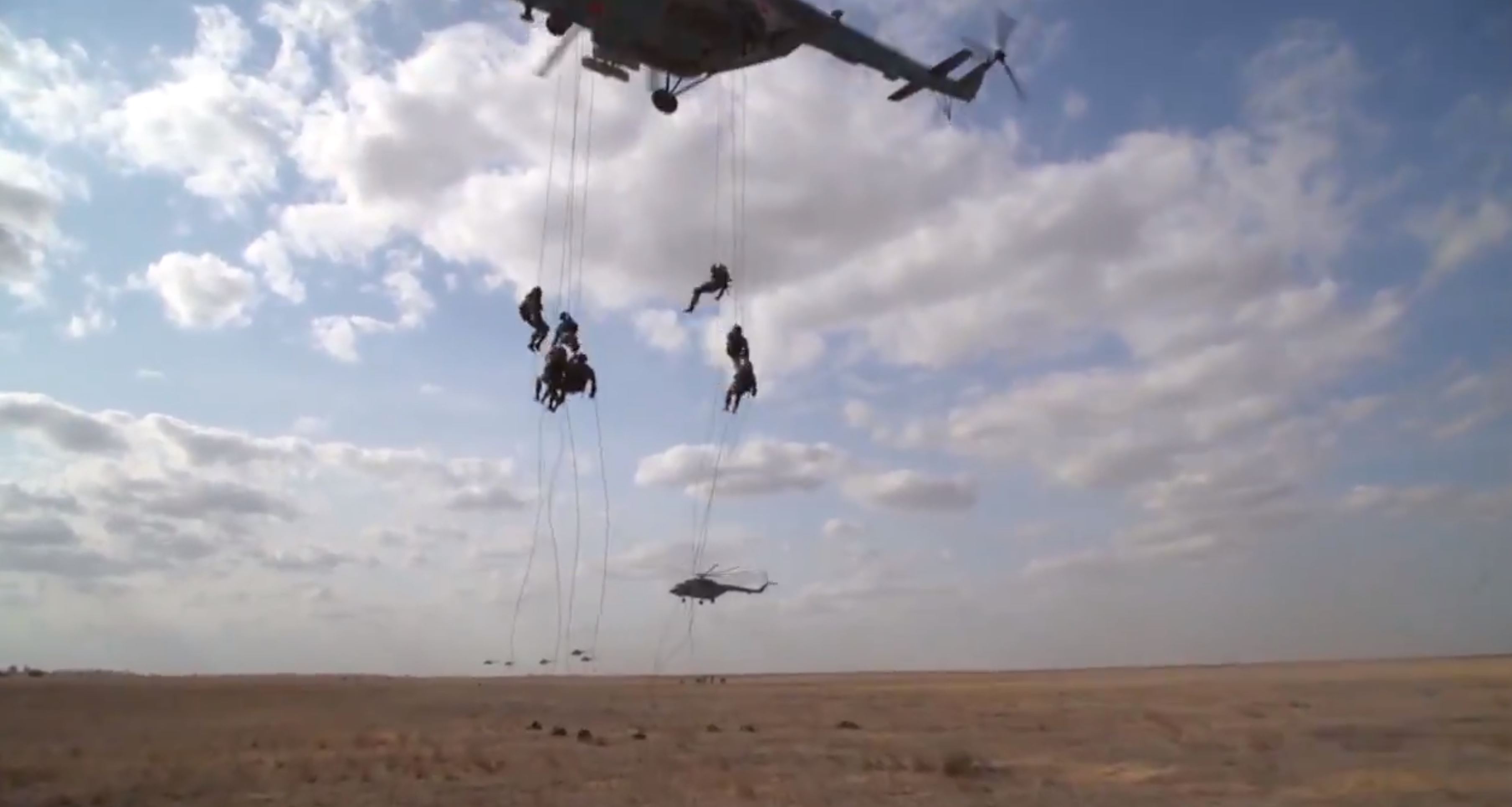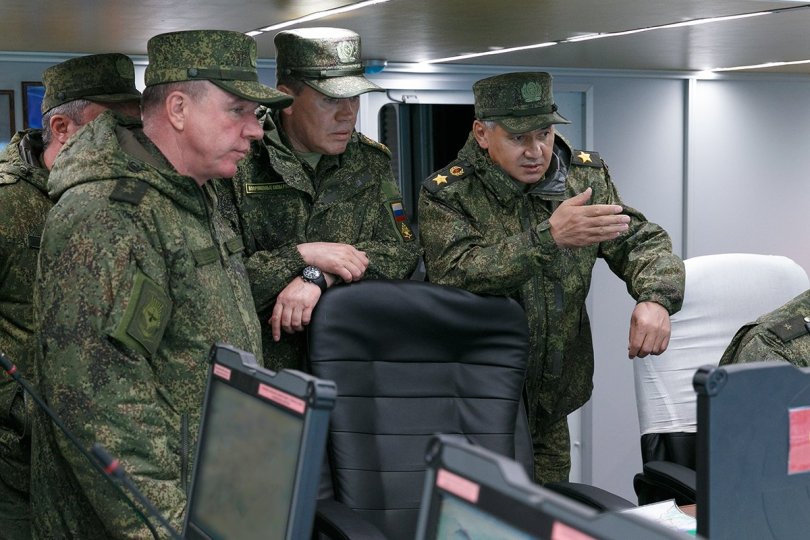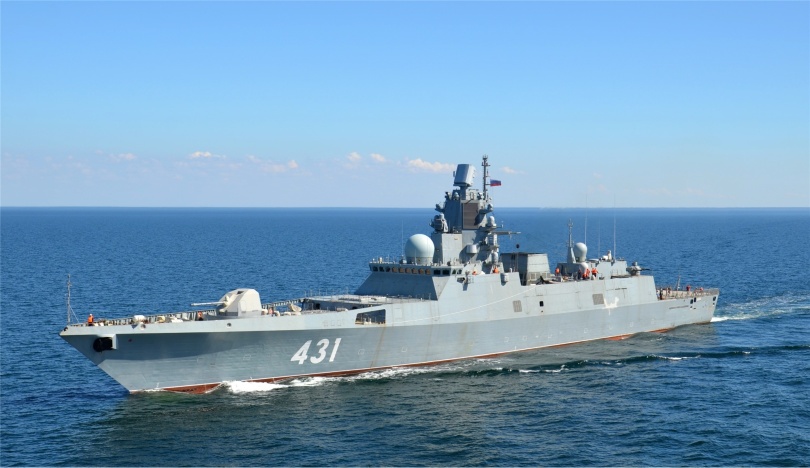September 24th featured a large exercise at Prudboy, with Airborne and motor rifle units conducting a complex maneuver, heliborne assault, flanking, artillery, and air defense. Aerospace forces continued practice at their ranges using both unguided and some guided munitions. Black Sea Fleet took center place with air defense exercises, some Kalibr fires from a submarine, while Caspian Flotilla seemed to be taking it easy compared to the previous day’s events. Ashuluk hosted a large artillery exercise with MLRS and sapper units blowing the hell out of things.
Aerospace Forces (VKS)
Tu-22M3 bombers, Su-34s and Su-24M2 (about 30 aircraft in total) conducted bombing runs at training ranges in Astrakhan oblast. These were chiefly FAB-250/500 bombs. Reconnaissance for the strikes done by Su-24MR aircraft. Flight groups were organized into pairs for tactical strikes and 4x aircraft for bombing runs. Bombing done at 1000 to 2000 meter altitudes, with air cover provided by Su-27 variants. Seems most of the units were from 4th Air and Air Defense Army.
Su-25SM3s based in Krasnodar conducted a strike against an enemy airbase, penetrating adversary air defenses, and then employing guided missiles and bombs (yes, a PGW strike for once) against infrastructure. Ten aircraft involved in total.

Airborne (VDV)
September 24th was spent loading. Probably 60x Il-76MD involved in a regimental level drop to take place at the exercise (more precise figures suggest 57 aircraft). Announced plans to drop 10 BMD-4Ms simultaneously on the 25th at Kapustin Yar using PBS-950U parachute systems and MKS-350. The 10 vehicles were loaded onto 5 IL-76MDs at Taganrog.

Prudboy training range (Volgograd)
Elements of the 56th Independent Guards Air Assault Brigade (VDV) were lifted in by Mi-8AMTSh helicopters to seize a platsdarm and then enable units from motor rifle battalions to conduct a successful flanking maneuver. Backed by mobile anti-tank units, VDV then attacked an enemy command post and took up an advantageous position to defend against counterattack. They were supported by 120mm mortars, but those were brought in by truck. The exercise expanded as motor rifle units and VKS joined in, with Mi-28N helicopters providing close air support along with Su-25s. Artillery units offered supporting fires in a counter attack that included Tornado-G and MSTA-S systems. To get a sense of the scenario, what they wargamed out was VDV being lifted into the rear of an enemy, then using ATGMs and other kit to destroy key armor, stalling the OPFOR, and enabling a larger counter attack by motor rifle formations who had supporting armor, land & air based fires. MLRS and tube artillery struck enemy reserves at 15km ranges prior to the main assault which used T-90As and BMP-3s, using aerosol cover to mask their assault. Drones were used to enable artillery targeting and BDA. The T-90As themselves had a separate scenario, camouflaged and detached from the main body of forces they ran target practice against moving targets at 700-2200 meter ranges, and then used smoke screens to displace.
This exercise involved one battalion of 500 airborne, 40 pieces of equipment, supported by BMP-2s from motor rifle units and PVO-SV air defense units. The ground force consisted of a sizable element, perhaps 1500, for a total of 2000 involved in the exercise. VDV brigades have been training with helicopter-based air assault tactics since at least Vostok-2018, as they workout a new type VDV with the ability for airborne units to seize key terrain ahead of advancing motor rifle formations or enable flanking maneuvers.
PVO-SV air defense units belonging to the ground forces used Tunguska-M1 and Verba MANPADS to destroy targets at an altitude of 2000 meters. They fired on 8x simultaneously launched targets and, get this, the timing of target launch was not announced in advance to the air defense units! It is of course comical that there would have been exercises in the past when air defense units would know exactly the time and direction of target launch, but this is progress.

Sniper training continued using ASVK and SVD rifles, this time at night. They used night time thermal imaging cameras to detect an enemy column, take out the vehicle’s engines and call in artillery using Strelets. Only problem with these exercises as reported from Prudboy is I’ve yet to see a picture of anyone actually wearing a night vision device. The Russian military certainly has them, its just a matter of seeing one in an exercise that is a bit of a rarity.
Ashuluk training range (Astrakhan)
Large artillery exercise, BM-21 Grads destroyed a mock enemy, supported by 2s19 MSTA-S and 2s1 Gvozdika SPA. Video showed MSTA-B towed artillery and other pieces involved, even ZU-23 guns. Just a lot of things being blown up.

Engineer-sapper and CBRN units belonging to 49th CAA mined a part of the range ahead of an expected OPFOR armored column with what read like a thermobaric or napalm based explosive of some sort. They lured enemy armor into the mined field and detonated a pyrotechnic element that essentially blocked the vehicles’ advance. About 500 soldiers participating from these units, recalling that CBRN units in the Russian military also field TOS-1A and now TOS-2 thermobaric 220m MLRS systems.
This appears to be the flame barrier used.

Kaputstin Yar (Astrakhan)
They’re promising a larger scale exercise at the final phase of Kavkaz-2020 where they intend to create what is consistently referenced as an operational envelopment (operational bag). Not sure why they use this term now because the general preference has been to use “kotel” which means boiler. This range offers, according to the press release, 60km x 120km exercise area. In the course of Kavkaz they expect to use 330 mock targets and 450 realistic targets – presumably moving targets, popup, and various types of imitators. Some of the higher end targets include Saman (high speed aerodynamic imitator), Adjutant which imitates aircraft, and missile targets U-95.
Meanwhile Chinese staff are preparing for their part of the main phase of the exercise.


Black Sea Fleet
A surface action group consisting of older project 1135M Pytlivy and Bora-class corvette Samym (this is that air cushion missile corvette) repelled an air attack using SAMs and AAA. They destroyed a target simulating an incoming missile, launches conducted by 2x Grisha-class anti-submarine corvettes project 1124M (Suzdalets and Muromets).

Improved-kilo 636.3 Kolpino fired a Kalibr cruise missile from a submerged position at a range of 100-150 nm (reports don’t agree) and hit a coastal range in Opuk. On the video it kind of looked like it was supposed to fire two and one failed to start. Couldn’t tell what I was looking at, but it seemed another missile sized object came out and fell back into the water. I suppose it could be the container, but not seen that before in previous Kilo launches.

Another surface action group was led by Slava-class guided missile cruiser Moskva consisting of 2x Buyan-M missile corvettes (Vyshny Volochyok & Orekhovo Zuyevo) and 4x project 1241.1M missile boats (Tarantul-III class). They also fired on simulated missile targets. A naval search and strike group, which they categorize separately from just regular naval strike groups, consisting of two more Grisha-class 1124M corvettes (Kasimov & Eysk), conducted launches with OSA SAMs against simulated enemy aircraft. The air targets themselves were small in size, imitating missiles, and were dropped from the old Be-12 amphibious planes belonging to BSFs naval aviation units.
Several BSF ships also deployed to block sea lines of communication near the Krasnodar coast. 2x Bykov-class large patrol ships project 22160 (Pavel Derzhavin and Dmitry Rogachev), along with a few small anti-saboteur boats (probably Grachonok-class) worked out a scenario where they located and destroyed adversary resupply ships attempting to provide logistics to their ground units deployed on the coast. One of the Bykovs also practiced recovering a Ka-27 helicopter in distress.
Commander in Chief of the Russian Navy, Adm Nikolai Yevmenov visited Sevastopol and later Novorossiysk to inspect fleet logistics and see how things were working during the exercise, including anti-submarine and counter-sabotage units.
Caspian Flotilla
A naval tactical group composed of Russian ships and Iranian vessels, again including Gepard-class Tartarstan, 2x Buyan-M class Veliky Ustyug & Astrakhan, and Iranian fast attack craft Paykan and Joshan (Sina-class) conducted artillery fire against naval and airborne targets. Naval targets were towed, while air attacks simulated but it is unclear if they used target imitators. Onshore targets were also engaged with shipborne artillery. The 177th also did some night time target practice with 120mm Sani mortars and BTR-82A APCs.

South Ossetia – A BTG belonging to 4th base, 58th Army, continued training against an imagined diversionary group. Main event for them will be on 25th as they switch to offensive operations. 1500 personnel involved with a fair bit of armor and air defense equipment.

Armenia – At the training range Alagyaz artillery units from both countries conducted live fire exercises using 2s1 Gvozdika 122mm SPA and 120mm Sani mortars. They employed radioelectronic means of targeting to destroy enemy forces at a range of 5km (fairly close but what do you want for a mortar exercise). Some language used to describe this exercise as leveraging tactical lessons from Syria, including the old ‘tank carousel’, nomadic tank, and scout tank. I’m not familiar with ‘nomadic tank’ – will have to check on that term later. Of course it is interesting that Azerbaijan chose to attack just as Kavkaz-2020 ended, considering that about 1500 Armenian soldiers are at this exercise with 300 pieces of equipment.

They tightened up reporting on Kavkaz-2020 at this point. Fewer news stories are out other than that being driven by MoD. Suspect there are more activities but not everything is being given airtime.
Special thanks to Konrad Muzyka (he runs Rochan Consulting and used to work at Janes) for helping put some of this info together.
Some good pictures to add from Prudboy

Mad Max fury road shot – units preparing for CBRN disinfection after the exercise











































































